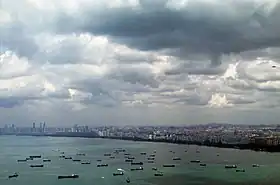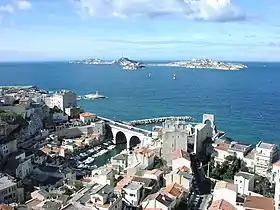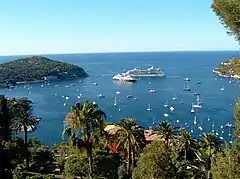Roadstead
A roadstead (or roads – the earlier form)[lower-alpha 1] is a body of water sheltered from rip currents, spring tides, or ocean swell where ships can lie reasonably safely at anchor without dragging or snatching.[3][4] It can be open or natural, usually estuary-based, or may be created artificially.[5] In maritime law, it is described as a "known general station for ships, notoriously used as such, and distinguished by the name".[6]
_01_ies.jpg.webp)
Definition
A roadstead can be an area of safe anchorage for ships waiting to enter a port, or to form a convoy. If sufficiently sheltered and convenient, it can be used for the transshipment of goods, stores, and troops, either separately or in combination. The same applies in transfers to and from shore by lighters.[3][lower-alpha 2] In the days of sailing ships, some voyages could only easily be made with a change in wind direction, and ships would wait for a change of wind in a safe anchorage, such as the Downs or Yarmouth Roads.
Notable roadsteads
- Basque Roads, France
- Bolivar Roads, Galveston, Texas, US
- Roadstead of Brest, France
- Carrick Roads, England
- Castle Roads, Bermuda
- Cherbourg Harbour (la Grande Rade), France (artificial)
- The Downs, England
- Fayal Roads, Azores, Portugal (Battle of Fayal)
- Gage Roads, Western Australia
- Hampton Roads, Virginia, US
- Kossol Roads, Micronesia
- Lahaina Roads, Hawaii, US
- Lingga Roads, Riau Islands, Indonesia
- Roadstead of Lorient, France
- The Nore, England
- Puget Sound, Washington, US
- Royal Roads, Canada
- Scapa Flow, Scotland
- Schillig Roads, Germany
- Spithead, England
- Tail of the Bank, Scotland (Clyde estuary)
- Roadstead of Tallinn, Estonia
- Tiefwasserreede, Germany
- Toulon Roads, France
- Road Town, Tortola, British Virgin Islands
- Rede van Texel, Texel, Netherlands (historic)
- Roosevelt Roads Naval Station, Ceiba, Puerto Rico
- Roadsteads around the world
 Singapore roadstead
Singapore roadstead Marseille Rade
Marseille Rade(Ludolf_Backhuysen%252C_1671).jpg.webp) Dutch ships in the roadstead of Texel, 1671
Dutch ships in the roadstead of Texel, 1671 Roadstead of Villefranche-sur-mer
Roadstead of Villefranche-sur-mer Greek bunker vessel AGIA ZONI III at Piraeus roadstead
Greek bunker vessel AGIA ZONI III at Piraeus roadstead Volvo Ocean Race 2012 in the roadstead of Lorient
Volvo Ocean Race 2012 in the roadstead of Lorient.jpg.webp) HNoMS Harald Hårfagre or Tordenskiold at the roadstead of Trondheim, 1906
HNoMS Harald Hårfagre or Tordenskiold at the roadstead of Trondheim, 1906 Golden Fleece lying at anchor in the roadstead (painting by Jack Spurling, 1929)
Golden Fleece lying at anchor in the roadstead (painting by Jack Spurling, 1929)
See also
Notes
- Charts and nautical publications often use roads rather than roadsteads.[1] Roads is the earlier term.[2]
- For example, in the Second World War, many merchant ships and many troops arriving at the UK were unloaded/disembarked from ships anchored at the Tail of the Bank in the upper Clyde estuary.[7]
References
- Walker, George K. Definitions for the Law of the Sea: Terms Not Defined by the 1982 Convention. Leiden: Martinus Nijhoff Publishers, 2012.
- Little, William; Fowler, H W; Coulson, Jesse; Onions, C T; Friedrichsen, G. W. S. (1983). The Shorter Oxford English Dictionary on Historical Principles (Volume II) (3rd ed.). London: Book Club Associates. p. 1838.
- United States Army technical manual, TM 5-360. Port Construction and Rehabilitation. Washington: United States. Government Printing Office, 1964.
- Oxford Dictionaries: Definition of roadstead in English
- Roadstead: Extensive Definition
- Black's Law Dictionary: What is roadstead?
- Robins, Nick (21 January 2014). "Clyde Anchorages Emergency Port". Scotland and the Sea: The Scottish Dimension in Maritime History. Seaforth Publishing. p. 175. ISBN 978-1-4738-3441-5.
External links
- Harbor Types of the World's Large Sized Ports Archived 2016-03-03 at the Wayback Machine, Hofstra University site
- Ports and Ocean Distances, searoutes.com
